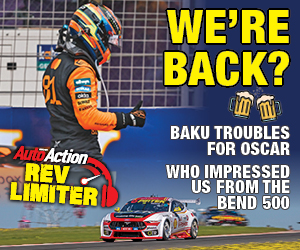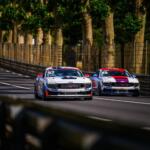WHEN CARS WERE TOO FAST FOR THE TRACK

Two decades ago, a race meeting was cancelled because the cars were too fast for the track. This unprecedented – and unrepeated – event had a profound effect on the series that was the victim of one of the most bizarre safety scares in motor sport history.
At the end of April, 2001, CART went to Texas Motor Speedway, a high-banked 1.5-mile (2.4 km) oval that has hosted some of the most heart-stopping IndyCar races ever. But CART cars back then were 900 horsepower ground-effect monsters unsuited to the head-spinning TMS.
They were literally too fast for the track.
Supercars champion Scott McLaughlin makes his oval racing debut at TMS this weekend in the double-header third round of the IndyCar Series.
Twenty years ago, CART went to TMS full of anticipation – and trepidation.
The arch-rival Indy Racing League had already raced at the high-banked 1.5-mile (2.4 km) oval without drama.
The slower IRL cars topped out at around 213 mph (343 km/h) average lap speeds. The CART contingent practised at up to 230 mph (360 km/h).
The difference was much more than the simple numbers. The g forces experienced by the CART drivers was off the chart. So much so that most experienced dizziness and nausea, while there were also reports that a couple blacked out momentarily on the track.
Amid much angst, CART cancelled the event mid-stream, as it had to. From the very off, the visit to TMS was ill-advised and fraught with unnecessary danger.
It is the only major motor sport event to my knowledge that was called off because the cars were too fast for the track.
Drivers blacking out due to sustained high g forces had never happened before – or since.
The debacle only highlighted the problems of CART – renamed Champ Car in 2002 – as it fought the Indy Racing League for open-wheel supremacy in the USA.
The 2001 season was the beginning of the end of CART/Champ Car. The TMS debacle was a body blow from which CART’s credibility, already undermined by weak management, never recovered.
In ’02, Penske and Chevrolet defected to IRL, followed in ’03 by Ganassi, Andretti Green, Rahal, and Honda and Toyota.
2001 was the first of my three seasons covering open-wheel racing for top-selling national newspaper ‘USA Today’ and the writing was already on the wall for CART/Champ Car.
The IndyCar ‘civil war’ was always going to be won by IRL because it had the Indy 500. And so it came to pass, despite Tony George’s excesses, with reunification in 2008.
2001-03 was a fascinating, but also frustrating, period in IndyCar history. IRL got stronger on the back of the Indy 500 as Champ Car imploded under new ownership, led by expat Aussie entrepreneur Kevin Kalkhoven.
Still far from the CART 1990s glory days, the IndyCar Series was revived under the leadership of Mark Miles since 2013.
Coincidentally, I had dealt with Miles back in my tennis reporting days. He was the first head of the ATP Tour, started in 1990 following a rebellion by male players.
Miles was the visionary administrator IndyCar needed and he still runs the series for new owner Roger Penske, who also bought the famed Indianapolis Motor Speedway.
IndyCar racing was always going to be over-run by NASCAR, which became a major league American sport in the early 2000s, but ‘The Split’ handed the France family commercial supremacy on a plate.
IndyCar is now – and has been for several years – the most competitive premier racing series in the world. But its broadcast audience remains sadly small, with even the Indy 500 a shadow of the TV ratings blockbuster it was for so long.
It is nearly 20 years ago that IndyCar’s long path back to legitimacy, if not popularity, began. Australian-born Kiwi star Scott Dixon, who won the title in his debut oval-only IRL season in ’03, is remarkably still there (with another five crowns since), joined this year by rookie compatriot Scott McLaughlin.
Dixon was at TMS in ’01 as a rookie with PacWest in ’01 and is there this weekend for the IndyCar Series double-header.
Indy racing at the Dallas-Fort Worth area speedbowl has always been fraught – razor-edge wheel-to-wheel battles and wins by hundredths of a second – but the speeds have been contained to survivable.
They’ve crept to close to 220 mph (354 km/h), but that is at the edge of the comfort zone.
Approaching 240 mph (386 km/h) lap average at the Indianapolis Motor Speedway is also breath-taking, but the wide-open 2.5 mile (4 km) rectangular course doesn’t generate the g forces of shorter high-banked ovals.
CART’s ill-advised experiment at Texas Motor Speedway – by far the best-promoted raceway in the USA – will live in infamy.
April 28, 2001 was the day the cars were declared too fast for a track, which had never happened before – or since.
In hindsight, it was a sensible decision to call it off because the danger was unacceptable. Lives were undoubtedly saved by the reluctant judgement.
As it was, 2001 was a fateful year for CART. The 9/11 terrorist attack saw the series stranded in Europe, racing at the Lausitzring in Germany and Rockingham in the UK.
I was at the Rockingham 500 and there was a pall over the event, not to mention the disruption caused by ‘weepers’ – track leakage – following rain.
It had been preceded by the post-9/11, hastily renamed American Memorial at the EuroSpeedway in Lausitz, East Germany, where Alex Zanardi lost his legs in an horrific accident.
It was just a very bad year for CART that sealed its fate.
For more of the latest motorsport news pick up the current issue of Auto Action. Also make sure you follow us on social media Facebook, Twitter, Instagram or our weekly email newsletter for all the latest updates between issues.





